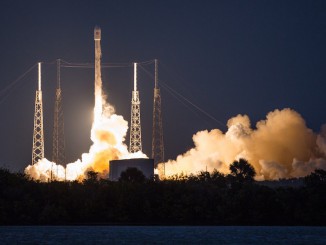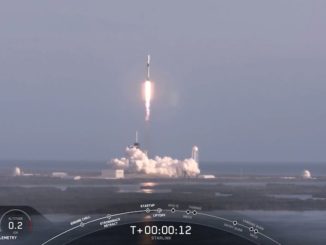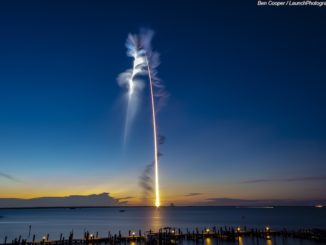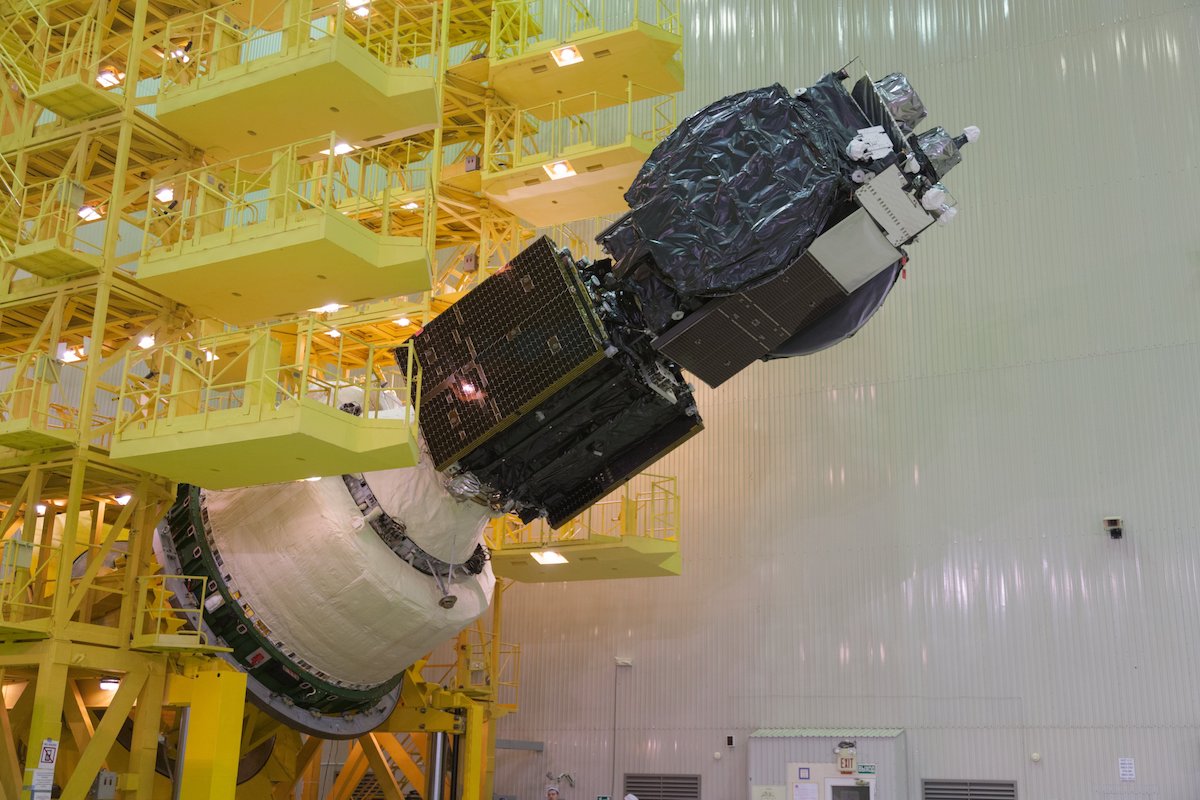
A pioneering Northrop Grumman-built satellite designed to dock with an aging spacecraft more than 22,000 miles above Earth, then extend its life with the aid of solar-electric thrusters, is set for launch Wednesday from Kazakhstan aboard a Proton rocket.
The first Mission Extension Vehicle, or MEV 1, will link up with an 18-year-old Intelsat communications satellite early next year. Once docked, the MEV 1 spacecraft will take over propulsion for the Intelsat 901 satellite, which is running low on fuel.
The satellite life extension service is provided by Space Logistics LLC, a wholly-owned subsidiary of Northrop Grumman, which built the satellite servicing platform.
MEV 1 is the industry’s first commercial servicing mission, and will attempt the first-ever docking between two spacecraft near geostationary orbit, a region more than 22,000 miles (nearly 36,000 kilometers) over the equator that is popular with communications satellite operators.
The satellite servicer will lift off at 1017:56 GMT (6:17:56 a.m. EDT) Wednesday of a 191-foot-tall (58.2-meter) Russian Proton rocket from Baikonur, a sprawling spaceport on the Kazakh steppe. Another Northrop Grumman-built satellite, destined to provide broadcast services for Eutelsat, will accompany the MEV 1 spacecraft on the Proton launch.
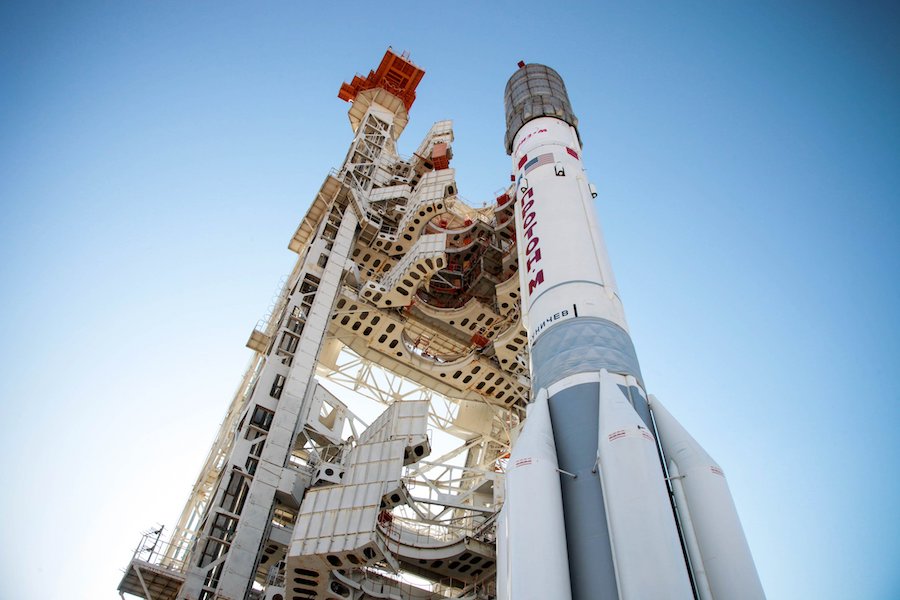
Liftoff from Site 200 at Baikonur is scheduled for 3:17 p.m. local time Wednesday to kick off a nearly 16-hour mission involving five firings by the Proton rocket’s Breeze M upper stage to deliver the Eutelsat 5 West B and MEV 1 satellites into a “supersynchronous” transfer orbit stretching more than 40,000 miles (65,000 kilometers) at its farthest point from Earth, with a low point around 7,500 miles (12,050 kilometers) above the planet, and an inclination of 13.4 degrees.
The 6,314-pound (2,864-kilogram) Eutelsat 5 West B satellite will ride on top of MEV 1 inside the Proton’s payload shroud. The Eutelsat satellite will separate from the Breeze M upper stage before MEV 1 at 0153 GMT Thursday (9:53 p.m. EDT Wednesday).
After a reorientation maneuver, the Breeze M upper stage will deploy the 5,127-pound (2,326-kilogram) MEV 1 spacecraft at 0212 GMT (10:12 p.m. EDT), according to International Launch Services, the U.S.-based company that oversees commercial Proton rocket flights.
Eutelsat 5 West B and MEV 1 will use their own propulsion systems to circularize their orbits near geostationary altitude, and reduce their orbital inclinations closer to the equator.
“Once Proton gets us to the to the transfer orbit, they will first deploy the Eutelsat satellite, about 20 minutes later, they’ll deploy the MEV,” said Joe Anderson, vice president of business development and operations at Space Logistics. “And then the MEV will begin its orbit-raising mission. That orbit-raising mission will take us about three to three-and-a-half months to get out to the rendezvous orbit. It takes that long primarily because we’re using mostly electric propulsion to do our orbit-raising.”
In the meantime, Intelsat controllers will send commands for the Intelsat 901 satellite to leave its operating position at 18 degrees west longitude and raise its altitude by nearly 200 miles, or 300 kilometers, to the so-called GEO graveyard orbit, where geostationary satellites are typically decommissioned.
“We will then, probably in the late January timeframe, rendezvous and dock with the spacecraft in that graveyard orbit,” Anderson said in an interview with Spaceflight Now. “We will do a little bit of testing there to demonstrate the capabilities of the combined stack, and then we will begin relocating it to its new operational location.”
The Mission Extension Vehicle will attempt its first docking in the GEO graveyard orbit to reduce the risk to other active satellites from space debris in the event of an accident.
The MEV is different from other satellite servicing concepts because it is strictly used for steering, pointing and relocating another spacecraft that is running low on propellant. The servicer will not refuel Intelsat’s satellites, which were never designed for dockings.
The Mission Extension Vehicle will latch on to the main engine of Intelsat 901, and other future client satellites. A liquid apogee engine is mounted to the base of about 80 percent of the communications satellites in geosynchronous orbit. The thruster is only used in the first few weeks after launch to put the satellite into its final orbit, then never fired again.
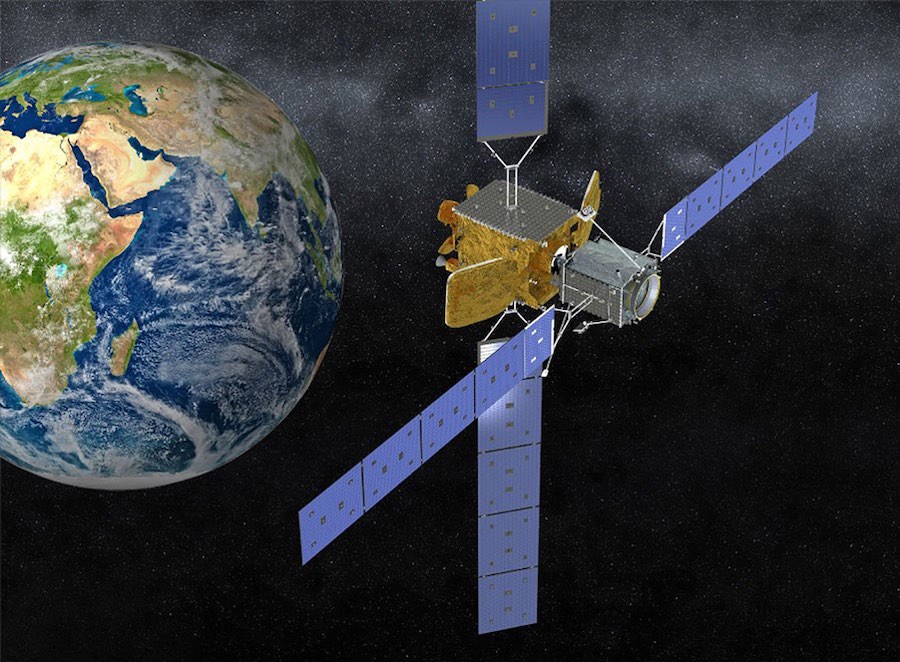
The approaching spacecraft has a stinger that reaches into the apogee rocket engine’s nozzle from about 3 feet (1 meter) out, and mechanical fingers will reach out and grab the target craft to pull the two satellites together.
The MEV has two deployable propulsion pods with efficient electric thrusters, little engines that generate very low thrust but can operate for hours or days at a time. There is also a small tank of liquid hydrazine fuel on-board, mainly for higher-impulse maneuvers during the docking sequence.
Ground teams at Northrop Grumman’s control center in Dulles, Virginia, and at Intelsat’s operations center in nearby Tysons Corner will oversee the rendezvous. Visible and infrared cameras, along with a scanning LIDAR sensor will collect range and closure rate data to feed into the MEV’s flight computer, while ground teams supervise the approach.
“As we approach the client, we sort of spiral in, circumnavigating the client and getting closer and closer until we achieve a position that’s about 80 meters (262 feet) behind the client satellite,” Anderson said. “At the 80-meter point — we call that a far hold — the MEV will stop at that location, and it will wait for ground command to proceed. This is where the supervised autonomy comes in.
“At this first waypoint, it waits for a ground command to say you have permission to proceed to the near hold point. So we give it the command to proceed, and it will autonomously go from the 80-meter far hold to the 20-meter (65-foot) near hold point. And then it will stop again at that 20-meter near hold point awaiting ground command to proceed on to the final waypoint, which is about 1 meter (3.3 feet) behind the client,” Anderson said.
“A ground command will give it permission to proceed on to that one-meter point, to the capture hold point. It will stop at the capture hold point, and then it will wait for ground command to tell it to go ahead and proceed with docking,” he said. “Once it receives that, it will autonomously complete the docking procedure.”
Officials plan a rendezvous rehearsal before attempting an actual docking. During the practice run, the MEV will close in to a distance of 262 feet from Intelsat 901 before backing off.
Once the satellites are docked, the MEV takes over attitude control and propulsion responsibilities, acting like a jet pack for the customer spacecraft.
The MEV’s fuel-efficient, xenon-fed ion thrusters will steer the Intelsat 901 satellite toward a new operating post at 27.5 degrees west longitude. Intelsat 901’s current orbit takes the satellite about 1.5 degrees north and south of the equator during each 24-hour orbit.
The Mission Extension Vehicle will guide Intelsat 901 back to a position directly over the equator.
“As we’re relocating into that new operational location, we will reduce the inclination,” Anderson said. “So we will remove that degree-and-a-half of inclination, so that when it is brought back into service, it will be fully station-kept. Intelsat will then operate the IS-901 spacecraft from that location for at least five years. They have an option to extend a couple more years if they wish.
“At the end of that five-year period, we will take the IS-901 satellite back to the graveyard orbit and undock from it there,” he said. “And then the MEV will move on and go to its next customer. The MEV is a multiple use spacecraft, and it will serve multiple clients during its lifetime.”
The Intelsat 901 satellite launched in June 2001 aboard an Ariane 4 rocket for a mission originally designed to last at least 13 years.
Intelsat, one of the world’s largest and oldest commercial satellite operators, signed up as the anchor customer for the Space Logistics satellite servicing program in 2016.
Satellite servicing is not new for Intelsat.
Astronauts flying on the space shuttle Endeavour installed a new upper stage on the Intelsat 603 satellite in 1992. Over the course of three spacewalks, Endeavour’s crew struggled to capture the cylinder-shaped communications satellite, which was stranded in an unusable orbit by a launch failure.
After two capture attempts turned up empty, space shuttle crew conducted the first — and so far only — spacewalk to be performed by three astronauts to grab the 4.5-ton satellite and connect a new kick motor to send it into geostationary orbit.
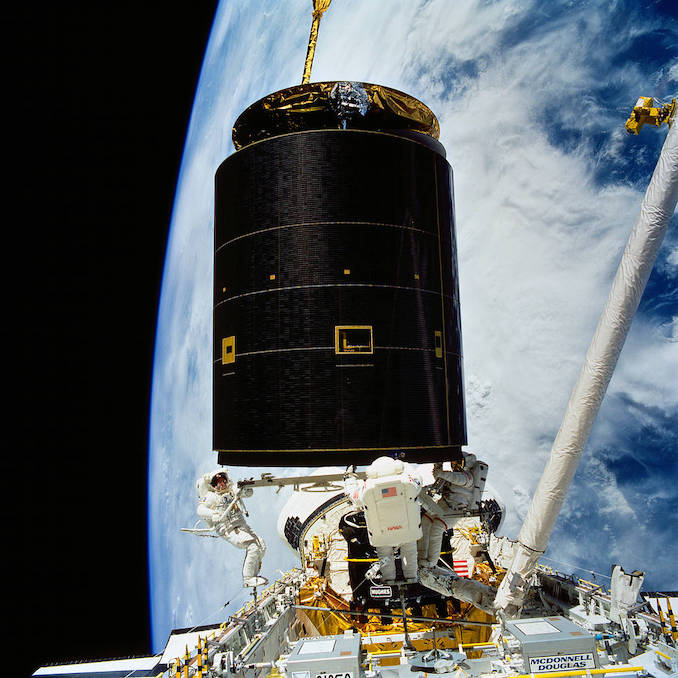
“Intelsat is, I believe, an industry thought leader … helping bring satellite servicing as a real capability to the industry,” Anderson said. “That will continue to grow and benefit them into the future. Intelsat has done a number of things like this in the past, and I think they are continuing to show their leadership.”
Ken Lee, Intelsat’s senior vice president of space systems, said in 2016 that Intelsat was excited about the capabilities of the Mission Extension Vehicle.
“From our perspective, it’s one of the tools in our toolkit,” Lee said. “So not all our satellites will have this business plan, but there are certain spacecraft that may suit well for this capability.”
The second Mission Extension Vehicle, set for launch in the second quarter of 2020, will also service an aging Intelsat communications satellite in geostationary orbit. The MEV 2 spacecraft will launch on top of an Ariane 5 rocket in tandem with Intelsat’s new Galaxy 30 communications satellite.
Customers can purchase MEV services on an annual basis.
For the MEV 1 mission, Intelsat is paying around $13 million per year for the life extension service, said Jacques Kerrest, Intelsat’s executive vice president and chief financial officer, in a quarterly earnings call earlier this year.
Northrop Grumman’s satellite servicing program has weathered several corporate mergers and acquisitions. The Mission Extension Vehicle started under ATK, a precursor to Orbital ATK, which formed in 2015. Northrop Grumman acquired Orbital ATK in 2018.
Anderson said the MEV relies on existing technologies.
The navigation sensors flown on the MEV are similar to rendezvous aids used on Northrop Grumman’s Cygnus space station supply ship, and the MEV spacecraft is based on Northrop Grumman’s flight-proven GEOStar design. The MEV also uses a docking structure based on devices developed by ATK for space shuttle servicing flights to the Hubble Space Telescope.
Maxar, a competitor with Northrop Grumman the satellite manufacturing business, is developing the Restore-L satellite servicing demonstration mission under contract to NASA that aims to refuel a Landsat Earth-imaging satellite, which orbits around 50 times closer to Earth than the geostationary altitude targeted by the the MEV.
Space Logistics received technical assistance from NASA during development of the MEV, but the government provided no funding. NASA’s assistance included support tasks in rendezvous and proximity operations, management of electro-static discharges between vehicles, robotics operator training, and the development of electric propulsion systems, the space agency said.
Maxar’s Restore-L mission is more technically complex, and involves the transfer of propellant and an in-space manufacturing and assembly demonstration with robotic arms. The MEV is simpler, and it’s a purely commercial effort.
But NASA and the U.S. military could be future customers for Space Logistics. The Aerospace Corp., a support contractor for government space programs, has a contract with Space Logistics to study the potential use of the company’s life extension services for U.S. military satellites.
“Once this capability has been demonstrated on MEV 1, NASA has the option of acquiring such a service in the future through a straightforward commercial acquisition instead of having to develop the capability ourselves at taxpayer expense,” said Phil McAlister, director of the commercial spaceflight division at NASA Headquarters. “It is big win for Northrop Grumman, NASA and the nation.”
“We do we foresee, eventually, moving into refueling,” Anderson said. “Currently, we believe that best approach for that is for satellites that have been prepared for refueling, versus trying to refuel satellites that have been launched without the compatible features that are necessary to do that.
“However, with that said, our strategy, versus some of our competitors and some of the things NASA has been looking at, has really been to keep it simple, and to incrementally add technology,” Anderson said. “The technology has been sufficiently validated, the risks are low enough, so that the risk level is compatible with the tolerance of our clients, so that we can sell those services.”
Space Logistics has plans for future satellite servicing vehicles. That may include additional MEVs, although there are no immediate plans to build a third Mission Extension Vehicle, Anderson said.
Instead, Space Logistics is developing a more advanced servicing vehicle with robotic arms that could attach propulsion packs directly to client satellites. Ion thrusters on the propulsion packs, or Mission Extension Pods, could provide orbit control services to a customer satellite for up to six years.
“Today, we feel refueling is a little bit of a longer stretch in terms of the incremental technology step,” he said. “So that’s why we chose to go to the MEV, and now to our Mission Extension Pods. But we do think refueling is is very quick to follow on the heels of our Mission Extension Pod concept, and we do look forward to getting to that approach.”
Email the author.
Follow Stephen Clark on Twitter: @StephenClark1.

